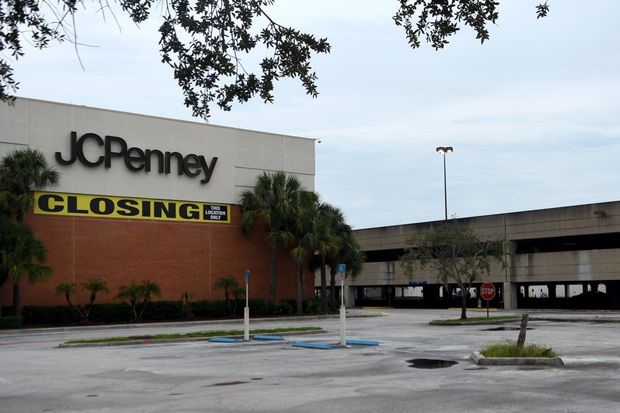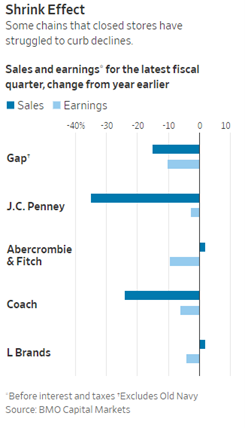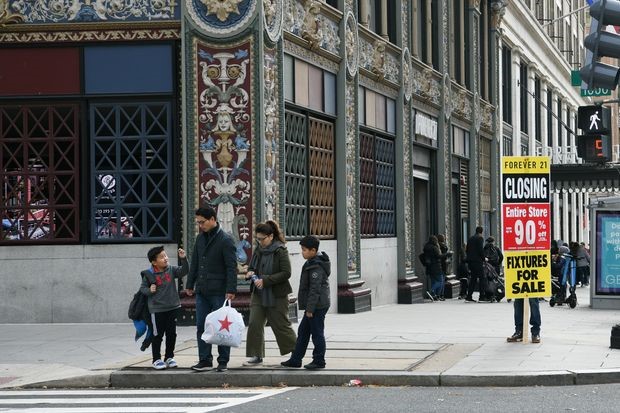
Penney, which filed for bankruptcy in May, also tried unsuccessfully to improve its performance by scaling back discounts.
PHOTO: PAUL HENNESSY/SOPA IMAGES/ZUMA PRESS
Retailers’ preferred solution for empty stores may only be adding to their problems, according to new research and industry executives.
Retail chains have announced thousands of closures this year after closing a record number of stores last year, as the pandemic crimps demand for nonessential items and shopping continues to migrate online.
The hope is that by cutting expenses associated with physical locations, the chains can become more profitable and start growing sales again as customer purchases shift to their remaining locations and websites. But that rarely happens, according to new research and interviews with industry executives.
“Closing stores isn’t going to solve a retailer’s underlying problems,” said Stephen Sadove, the former chief executive of Saks Inc. “You have to look at why the stores aren’t performing. What is their competitive advantage and their reason for being?”
Even before the pandemic, retailers were closing stores at a record pace. U.S. chains announced the closure of 9,275 outlets last year, the most since Coresight Research Inc. began tracking the figures in 2012. The tally exceeds 8,000 stores so far this year, according to Coresight.
The health of the industry will be on display this week as chains from Walmart Inc. to Macy’s Inc. report quarterly earnings, with the holiday shopping season already under way. Chains began offering Black-Friday-type discounts in October, instead of waiting until the traditional day after Thanksgiving.
 Retailers that closed stores in recent years often continued to shrink, sometimes to the point of disappearing altogether, according to research from Citigroup Inc. and BMO Capital Markets. The firms looked at roughly a dozen retailers that announced major store closings in recent years, including Macy’s, J.C. Penney Co., Abercrombie & Fitch Co. and L Brands Inc.
Retailers that closed stores in recent years often continued to shrink, sometimes to the point of disappearing altogether, according to research from Citigroup Inc. and BMO Capital Markets. The firms looked at roughly a dozen retailers that announced major store closings in recent years, including Macy’s, J.C. Penney Co., Abercrombie & Fitch Co. and L Brands Inc.
An Abercrombie spokeswoman said the company still believes in stores, but they need to be the right size and in the right location. As its digital business has grown, the retailer remains committed to reducing its square footage, but continues to open smaller stores, she said.
Macy’s, Penney and L Brands declined to comment.
“No retailer ever announces one round of store cuts—it’s always the precursor to a store bleed,” said Simeon Siegel, a BMO senior analyst. “Most companies we looked at had lower revenue and profit than before they started closing stores.”
Two exceptions were Nike Inc. NKE and American Eagle Outfitters Inc. Mr. Siegel said the two companies closed stores more as part of a normal pruning of undesirable locations, rather than the mass closures of other chains.
Nike didn’t respond to a request for comment. An American Eagle spokeswoman said the chain’s fleet is largely profitable, but it continues to evaluate and reposition stores as part of its ongoing strategy.
Mr. Siegel said the problem is often not that chains have too many stores, but that they have diluted their brand with too many discounts. A healthier approach would be to sell fewer items and charge more for them, he said. The result would be a smaller, but more profitable company.
That didn’t work for Penney, which scaled back discounts under previous management only to watch shoppers flee. Other brands, including Coach and Ralph Lauren, are having more success weaning customers off promotions. But it isn’t easy to do in a world where retailers are rewarded by investors for growing sales, Mr. Siegel said.
In his view, Wall Street’s focus on sales growth contributed to the overstoring of America over the past half-century. “All a retailer had to do was open a new store,” Mr. Siegel said. “It became more important to be bigger, not better.”
The rise of e-commerce put an end to the store-opening juggernaut. As consumers bought more online, they visited physical stores less, making them less productive and more costly to operate. That led chains to close hundreds of locations with the hopes of stabilizing profits. For some, the strategy hastened their decline, analysts said.
“When you look at all the retailers that are closing stores now, it’s easy to forget that so many have tried this in the past and they aren’t around anymore,” Citigroup analyst Paul Lejuez said.
Retailers cast store closings as a necessary fix, and sometimes their businesses are under so much pressure they don’t have a choice.
“We believe this is an important step, a good step for the long-term health and profitability of the business,” L Brands finance chief Stuart Burgdoerfer told analysts in August about plans to close 250 Victoria’s Secret stores this year.

Shoppers in Washington, D.C., last November. This year holiday promotions started earlier.
PHOTO: LOREN ELLIOTT/REUTERS
Mr. Burgdoerfer said Victoria’s Secret expects to recapture roughly 30% to 40% of sales from shuttered locations, as shoppers transfer their purchases to a nearby outlet or the internet. The lion’s share will go to other stores in the chain, he said, with only 5% expected to be reclaimed online.
In many cases, though, a purchase is lost for good.
Tommia Hayes said she is shopping less at Forever 21, Gap and Foot Locker FL +2.07% since they closed stores near her Washington, D. C., home in recent years
“When I walk by a store and see a cute display in the window, that makes me want to go inside,” said Ms. Hayes, who works for a health-care nonprofit. “If the store isn’t there, I’ll just go someplace else.”
Real-estate executives said shoppers typically won’t travel more than three to five miles to a store, although that can vary depending whether they live in a rural or urban area and on the type of retailer.
“I call it the 20-minute rule,” said Jim Bieri, a principal of Stokas Bieri Real Estate, a Detroit-based broker. “Once it’s farther than 20 minutes, people won’t come.”
William McComb, who closed stores as CEO of Fifth & Pacific Cos.—which at the time owned Kate Spade, Juicy Couture and Lucky Brand Jeans—said when a store closes shoppers don’t always move online. In fact, e-commerce sales can suffer unless retailers have spent to build a web presence, he said.
“Stores are a demand-generation machine,” Mr. McComb said. “Consumers don’t automatically go to your website. It’s very expensive to get the eyeballs.”
The risk of shrinking-to-grow—which is how some retailers describe their store-closing strategies—is that chains aren’t always able to cut enough costs to offset the lost sales and shore up profit margins, analysts and executives said.
“The money saved from closing stores ends up being deployed on marketing,” BMO’s Mr. Siegel said.
As a result, he said, marketing costs, which historically averaged around 3% of sales, have inched up to about 4.5% of sales for the bricks-and-mortar chains that he follows. For online brands that have few if any stores, marketing can average upward of 15% of sales, he said.
“The argument of the past 15 years has been that e-commerce has diminished the need for stores,” Mr. Siegel continued. “But every company that has embarked on massive store closings has simply gotten smaller.”
Source: The Wall Street Journal, November 16, 2020 | Suzanne Kapner